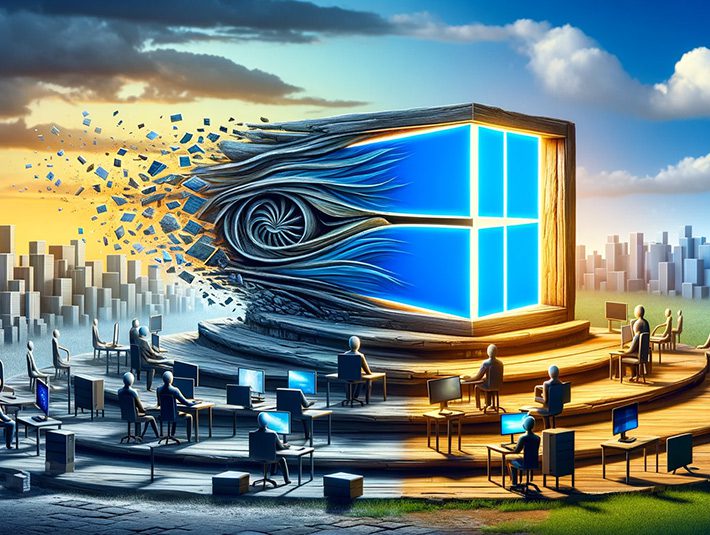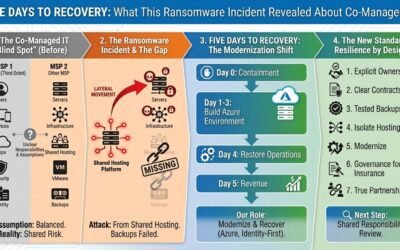The end of support for Windows 10 on October 14, 2025, marks a significant milestone in the evolving landscape of technology. This is not just a routine software update for CEOs and business leaders of small and medium-sized businesses in Canada; it’s a critical juncture that demands attention and action. As technology rapidly advances, staying updated is no longer a choice but a necessity for business continuity and competitiveness.
Windows 10 is End-of-Life in
Day(s)
:
Hour(s)
:
Minute(s)
:
Second(s)
The transition from Windows 10 to Windows 11 presents an opportunity to update your systems and future-proof your business operations strategically.
Increased Vulnerabilities with Outdated Technology
Holding onto older devices running Windows 10 may seem cost-effective in the short term, but it comes with increased risks. Outdated systems are more vulnerable to security threats, potentially exposing your business to significant risks and losses. For a detailed exploration of why upgrading old office technology is a sound investment, particularly in the context of SMBs, check out our previous article.
Economic Impact of Windows 11
Transitioning to Windows 11 isn’t just about mitigating risks; it’s also about leveraging new opportunities. According to studies like The Total Economic Impact™ of Windows 11 Devices, businesses can expect significant returns on their investment in the new OS.
Recent findings from the study conducted by Forrester Consulting reveal compelling economic benefits of transitioning to Windows 11. Businesses can expect a staggering 250% return on investment over three years, with financial gains amounting to $2.45 million and a net present value of $1.75 million. This underlines the cost-effectiveness and the strategic advantage of upgrading to Windows 11. Enhanced security features and increased productivity for IT teams further solidify Windows 11 as a prudent choice for businesses aiming to stay at the forefront of technological advancement.
From improved security features to enhanced productivity tools, Windows 11 is designed to provide a more robust, efficient, and secure computing environment.
Planning Your Migration
The journey to Windows 11 should begin with a strategic deployment and migration plan. By starting now, you can ensure a smooth transition that minimizes disruptions to your operations. Consider the following steps to create an effective migration strategy:
- Step 1 – Audit Your Current Systems: Conduct a thorough audit of your current systems, identifying which devices are eligible for an upgrade and which may need replacing. Assess the security implications of your devices and software, mainly focusing on known vulnerabilities.
- Step 2 – Understand Hardware and Software Requirements: Ensure your devices meet Windows 11’s hardware requirements. Verify software compatibility, as most applications that work on Windows 10 should also function on Windows 11.
- Step 3 – Test Application Compatibility: Rationalize your application estate and test for compatibility with Windows 11. Consider automating application packaging and testing (we have a few tools that we love using).
- Step 4 – Review License Requirements: Understand the licensing and activation procedures for Windows 11, particularly if you plan to transfer Windows 11 to new computers (if you’re using Microsoft 365 Business Premium, a key component of our Workplace Suite, Windows 11 upgrade rights are included with machines running Windows 10 version 2004 or later).
- Step 5 – Create a Deployment Plan: Define early adopters and evaluate your infrastructure. Prepare your helpdesk for the new user interface and update training materials accordingly.
- Step 6 – Embrace Cloud-Based Management: Consider using cloud solutions such as Microsoft Endpoint Manager, Windows Autopilot, and Microsoft Intune for easier rollout and ongoing management (especially if you need to acquire new laptops or desktops).
- Step 7 – Ensure Compatibility with Managed and Unmanaged Devices: Understand how both managed and unmanaged devices will receive the Windows 11 upgrade. Think of those devices which roam with travelling employees that may never connect to the network (Microsoft Intune can help here).
Conclusion
As a forward-thinking business leader, embracing Windows 11 is not just about staying current; it’s about staying competitive and secure in a rapidly evolving digital landscape. The end of support for Windows 10 is an opportunity to modernize your IT infrastructure, enhancing your business’s efficiency and security.
Ready to Begin Your Transition?
At Third Octet, we understand the challenges and opportunities of technological transitions. For over 15 years, we’ve provided outstanding IT support and innovation, ensuring your businesses stay ahead of the game. Our Managed IT Services are designed to fit today’s challenges, delivering solutions perfectly scaled to your needs, whether you’re a small team or a large enterprise.
With Third Octet, you gain access to expert knowledge in key technologies like Microsoft Azure and Microsoft 365, and a range of industries from financial services to healthcare. We focus on creating tailored solutions that align with your unique business needs and growth stage.
Don’t navigate this transition alone. Contact us at 647-728-0610 or info@thirdoctet.com, and let us make your migration to Windows 11 seamless, efficient, and strategically advantageous for your business.




0 Comments